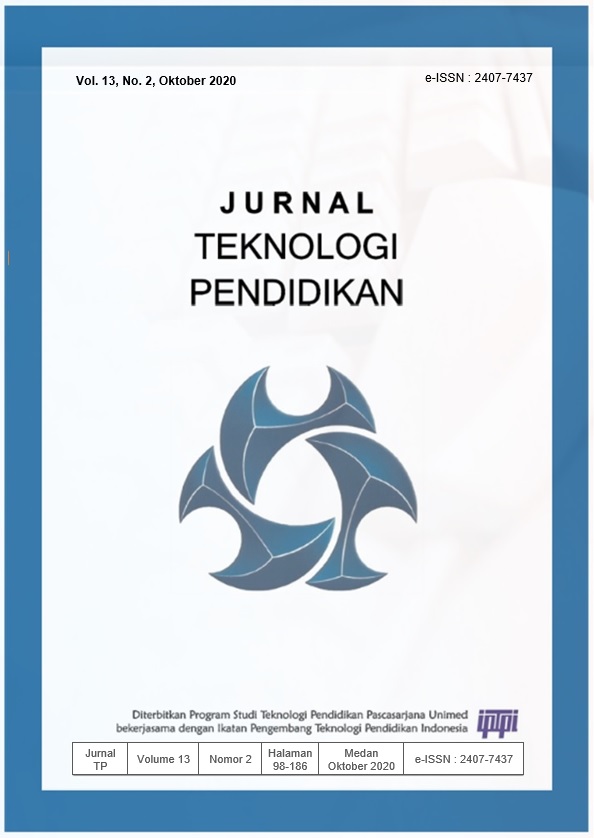UPAYA MENINGKATKAN KEAKTIFAN MAHASISWA DALAM MENGANALISIS VIDEO PEMBELAJARAN MELALUI STRATEGI PEMBELAJARAN WEBINAR
DOI:
https://doi.org/10.24114/jtp.v13i2.20149Abstract
Abstrak: Penelitian ini bertujuan meningkatkan keaktifan mahasiswa dalam menganalisis video pembelajaran melalui strategi pembelajaran webinar. Penelitian ini merupakan penelitian tindakan kelas yang terdiri atas empat tahapan yaitu: (a) tahap perencanaan, (b) tahap pelaksanaan,(c) tahap observasi, (d) tahap analisis dan refleksi. Subjek dalam penelitian adalah mahasiswa semester VI Program Studi Pendidikan Guru Sekolah Dasar Fakultas Keguruan dan Ilmu Pendidikan Universitas Terbuka kelompok belajar Kota Medan pada tahun pelajaran 2020.1. Pelaksanaan penelitian tindakan kelas ini dilakukan pada matakuliah Pemantapan Kemampuan Mengajar dengan jumlah mahsiswa 12 orang. Teknik pengumpulan data pada data kuantitaif menggunakan instrumen tes kemampuan mahasiswa dalam menganalisis video pembelajaran dalam bentuk pilihan berganda, dan pada data kualitatif menggunakan hasil observasi keaktifan mahasiswa dalam menganilisis video pembelajaran dikelas webinar dan keaktifan dosen dalam mengajar dengan menggunakan strategi pembelajaran webinar. Hasil penelitian ini menunjukkan terdapat peningkatan keaktifan mahasiswa dalam menganalisis video pembelajaran dengan menggunakan strategi pembelajaran webinar.Kata Kunci:Keaktifan Mahasiswa, VideoPembelajaran, Strategi Pembelajaran Webinar Abstract: This study aims to increase student activity in analyzing instructional videos through a webinar strategy. This research is a classroom action research consisting of four stages namely: (a) the planning stage, (b) the implementation stage, (c) the observation stage, (d) the analysis and reflection stage. The subjects in the study were students of the 6th semester of the Primary School Teacher Education Study Program, Faculty of Teacher Training and Education, the Open University of the Medan City study group in the 2020.1. school year. The implementation of this classroom action research was carried out in the Teaching Ability Consolidation course with a total of 12 students. The technique of collecting data on quantitative data uses a student ability test instrument in analyzing learning videos in the form of multiple choices, and qualitative data uses the results of observations of student activeness in analyzing learning videos in the webinar class and lecturer activeness in teaching using webinar learning strategies. The results of this study indicate that there is an increase in student activeness in analyzing learning videos using webinar learning strategies.Keywords: Student Activity, Learning Videos, Webinar Learning StrategiesReferences
Adnan, Muhammad. & Anwar, Kainat. (2020). Online Learning Amid the COVID-19 Pandemic: Students' Perspectives. Journal of Pedagogical Sociology and Psychology. Volume 2, Issue 1, 2020. Diakses pada Tanggal 19 September, Dari http://www.doi.org/10.33902/JPSP.
Basilaia, G., & Kvavadze, D. 2020. Transition to Oline Education in Schools During a SARS-CoV-2 Coronavirus (Covid-19) Pandemic in Georgia. Pedagogical Research, Volume 5 (4).
Bates, A. W. (2015). Teaching in A Digital Age; Guidelines for Designing Teaching and Learning for A Digital Age. Open.Bc Campus. Diakses dari http://opentextbc.ca/teachinginadigitalage.
Crawford, J. Butler-Henderson, K. Rudolph, J., & Glowatz, M. (2020). COVID-19: 20 Countries' Higher Education Intra Period Digital Pedagogy Responses. Journal of Applied Teaching and Learning (JALT). Volume 3.(1).
Kay, R. H. (2012). Exploring The Use of Video Podcasts in Education: A Comprehensive Review of The Literature. Computers in Human Behavior, Vol.28, No.3.
Fahrurozi, Slamet Kurniawan. Maryono, Dwi. & Budiyanto, Cucuk. (2017). The Development of Video Learning to Deliver a Basic Algorithm Learning. Indonesian Journal of Informatics Education. Volume 1, Issue 2. Desmber 2017.
Humphrey, R. L. Le Grand, C. S. & Beard, D. F. (2013). How to Host a Successful Webinar. Journal Strategic Finance. Vol 95. Issue 1.
Harrison, Lauren. (2014). Case Study on the First-time Use of a Webinar by a Small Marketing Firm. Professional Projects from the College of Journalism and Mass Communications. Lincoln:University of Nebraska. Diakses pada Tanggal 19 September, Dari http://digitalcommons.unl.edu/journalismprojects/1
Kemmis & Mc. Taggart. (2010). The Action Research Planner. Geelong: Deaken Univercity Press.
Pace, C., Pettit, S. K., & Barker, K. S. (2020). Best Practices in Middle Level Quaran Teaching: Strategies, Tips and Resources Amidst COVID-19. Becoming: Journal of the Georgia Association for Middle Level Education. 31(1), 2.
Sugiyono (2015). Metode Penelitian Kombinasi (Mix Methods). Bandung: Alfabeta.
Susilawati, Evi. (2017). The Effect of Modeling Learning Strategy and Cooperative Behavior on Civic Education Learning Achievement. Advances in Social Science, Education and Humanities Research, Volume 104.
Susilawati, Evi. (2020). Aplikasi Tutorial Berbantuan Web Untuk Meningkatkan Hasil Belajar Matakuliah Pembelajaran PKn di SD di Tengah Pandemi Covid-19. E Prosiding Seminar Nasional Virtual Pendidikan Kewarganegaraan 2020. Penguatan Pendidikan Kewarganegaraan di Indonesia Pada Era Digital. Diakses dari http://C:/SeminarPPKNUNS
Wang, Shiang-Kwei. & Hsu, Hui-Yin. (2008). Use of the Webinar Tool (Elluminate) to Support Training: The Effects of Webinar-Learning Implementation from Student-Trainers™ Perspective. Journal of Interactive Online Learning. Volume 7, Number 3.
Zhong, R. (2020). The Coronavirus Exposes Education™s Digital Divide. The New York Times. March, 17. Diakses dari https://www.nytimes.com/2020/03/17/technology/china-schools-coronavirus.html
Downloads
Published
How to Cite
Issue
Section
License

Jurnal Teknologi Pendidikan (JTP) is licensed under a Lisensi Creative Commons Atribusi 4.0 Internasional.




